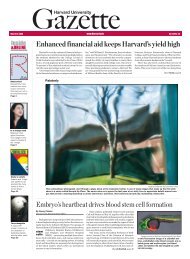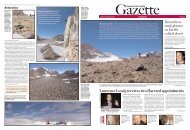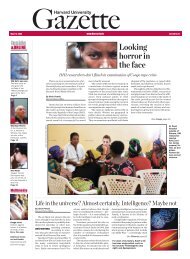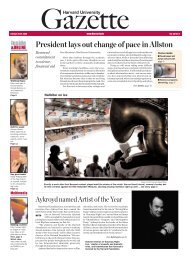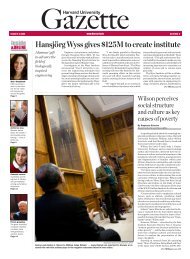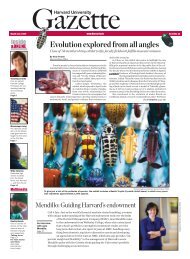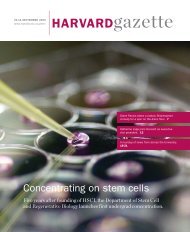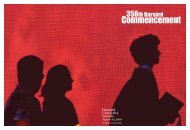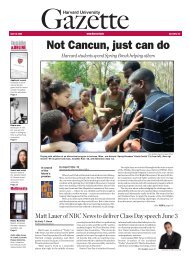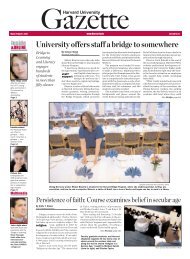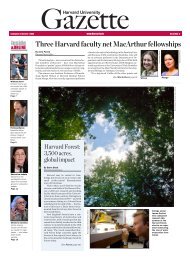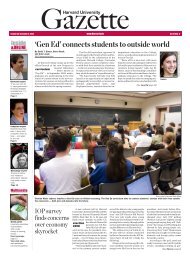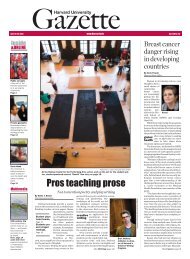Harvard University Gazette December 4-10, 2008 - Harvard News ...
Harvard University Gazette December 4-10, 2008 - Harvard News ...
Harvard University Gazette December 4-10, 2008 - Harvard News ...
You also want an ePaper? Increase the reach of your titles
YUMPU automatically turns print PDFs into web optimized ePapers that Google loves.
34/ <strong>Harvard</strong> <strong>University</strong> <strong>Gazette</strong> <strong>December</strong> 4-<strong>10</strong>, <strong>2008</strong><br />
Rosalind Chait Barnett receives HGSE’s Anne Roe Award<br />
Rosalind Chait Barnett, director of the Community,<br />
Families & Work Program at Brandeis <strong>University</strong>, received<br />
the <strong>2008</strong> Anne Roe Award from the <strong>Harvard</strong><br />
Graduate School of Education (HGSE) on Nov. 17. The biennial<br />
award was established in 1979 to honor Anne Roe,<br />
the first woman tenured at <strong>Harvard</strong> in, 1963, and also a<br />
leading researcher on career development and women.<br />
In presenting the award to Barnett, HGSE Dean<br />
Kathleen McCartney said, “Rosalind Barnett has played<br />
an extraordinary role in dispelling conventional ‘wisdoms’<br />
about the capability and capacity of girls and<br />
women. Her rigorous research has challenged some of<br />
our culture’s most entrenched and harmful gender<br />
stereotypes.”<br />
Barnett’s lecture, titled “Women’s Journey Toward<br />
Equality: Where We Are and the Path Ahead,” focused on<br />
how traditional gender roles are relaxing.<br />
“Women’s lives today are dramatically different<br />
[from] those of their mothers and grandmothers,” Barnett<br />
said. “Women are making choices that will prepare<br />
them for longer lives, significant labor force participation<br />
with marriage and children, knowing that they are<br />
contributing to their own economic well-being, getting<br />
more education, and proving themselves in well-paying<br />
employment.”<br />
Barnett has published numerous articles and seven<br />
books, including the “Same Difference: How Gender<br />
Myths Are Hurting Our Relationships, Our Children, and<br />
Our Jobs,” (Basic Books, 2005) co-authored with Caryl<br />
Rivers. Additionally, Barnett is currently collaborating<br />
with the <strong>Harvard</strong> School of Public Health, and Catalyst<br />
and Work/Family Directions on various research projects.<br />
Art<br />
(Continued from page 18)<br />
are by Boris Sveshnikov, who worked<br />
primarily with pen on paper while incarcerated<br />
as a political prisoner in the<br />
Gulag. “Almost no visual records of the<br />
Gulag have survived, making Sveshnikov’s<br />
art all the more important,”<br />
says Katsnelson. “While images documenting<br />
the Holocaust or the mushroom<br />
cloud over Hiroshima are immediately<br />
recognizable, no similar representation<br />
of the Gulag exists.”<br />
Another artist whose work will be<br />
exhibited, Eugeny Rukhin, died in a fire<br />
in his studio at the age of 32. The cause<br />
of the fire is unknown, but it is suspected<br />
that the KGB played a role, reacting<br />
to Rukhin’s close ties to foreigners<br />
such as Dodge.<br />
Many of the smuggled works date<br />
from the 1960s, during Khrushchev’s<br />
“thaw,” explains Katsnelson. At this<br />
time, Soviet artists were first exposed<br />
to recent Western art, as well as to<br />
Russian works from the early part of<br />
the 20th century, which had been previously<br />
banned in their own country.<br />
Despite a softening of the political<br />
landscape, nonconformist artists’<br />
work during this period was still illegal,<br />
and, if discovered, would have been destroyed.<br />
By buying this art directly from<br />
the artist, without a receipt<br />
so that there was no<br />
record of the transaction,<br />
Dodge offered the<br />
artists a possible audience<br />
for their work. Interest<br />
in nonconformist<br />
art has been relatively<br />
rare in the West, although<br />
recently it has<br />
gained more attention.<br />
Among the more prominent<br />
artists whose works<br />
will be on show at the<br />
Davis Center are Boris<br />
Mikhailov, Mikhail Chemiakin,<br />
and Ernst Neizvestny.<br />
The exhibition is organized<br />
in conjunction<br />
with the Davis Center’s<br />
60th anniversary, an occasion<br />
for reflecting on<br />
the past and anticipating<br />
the future of Russian and<br />
Eurasian studies. “In the<br />
Western world, freedom<br />
of expression is often taken for granted,” says Katsnelson.<br />
“We forget that art, although ephemeral,<br />
can speak truth to power.”<br />
Yuri Rybchinsky’s ‘Untitled,’ from the series ‘Correctional Colony,’ 1978.<br />
© <strong>2008</strong> Artists Rights Society (ARS), New York/ADAGP, Paris<br />
Oscar Rabin’s ‘Untitled,’ 1969 (above). Boris Smelov’s<br />
‘Nickel Soup Tureen,’ 1972 (right).<br />
amy_lavoie@harvard.edu



